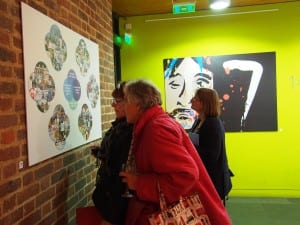Communicating without words: the power of art as a tool of expression
By news editor, on 24 October 2013
![]() Written by Maria Black, retired UCL clinical linguist
Written by Maria Black, retired UCL clinical linguist
What would you do if a stroke or head injury robbed you of your ability to communicate verbally? How would you preserve your sense of self and connection to the world if understanding language became unreliable, your speech disappeared, or your capacity to read and write shrank?
‘Communicating without words’, an innovative exhibition organised by the UCL Communication Clinic, offers us a unique opportunity to explore these questions through the art and experiences of artists with language and communication difficulties. The free exhibition takes place from 14-29 October 2013 in The Lumen Gallery.
Although aphasia affects more than 367,000 people in the UK and aphasiology is a well-established multi-disciplinary research field, there is little public awareness of this condition, which can occur at any age.
The artworks in this exhibition, together with an excellent guide and video interviews with four of the artists, directly show us how we can find new means of communication, even when we are lost for words.
The exhibition starts with works reminding us that our faces, eyes, mouths and hands are not just body parts but also means of social connection and expression, as well as creative tools.
Terry Cooney’s black and white photographs of another artist in the exhibition demonstrate how powerfully emotion can be transmitted solely through facial expression and body language. The photographs are of high quality, even though Terry now has to hold and operate his Nikon D80 with his left-hand since a stroke took away mobility and sensation on the right side of his body.
Stuart Midgley, portrayed in these photographs, was forced by his stroke to abandon his career as an actor, antique restorer and sculptor. A beautifully sculpted hand from before his stroke shows us how skilled he was.
Yet, in spite of the loss of fine motor control, his post-stroke ceramic heads have a rare expressive power and emotional depth.
Hanging next to them is a knitted textile in subtle but vibrant colours. Isabella Ilyama taught herself to knit with one hand after suffering a stroke on a plane to Nigeria.
Isabella, an artist and solicitor with a successful London law practice, woke up from an extended coma to find herself paralysed on her right side, unable to speak, write or read.
Mike Austin’s digital paintings take us on a journey through stroke and its effects. Mike, the creative director of an international advertising firm in the Middle East, had a stroke while driving to work.
He was 47 and was left with a right-side paralysis and severe aphasia that restricted all forms of verbal communication. He nevertheless retained his computer and graphic skills and began to paint again as he recovered.
His pieces are bold, with a directness and expressive economy that makes them profoundly moving. A piece in two sections shows on one side a hospital room: Mike lying in his bed, with his wife and daughter seated at his bedside.
The colours and artificial light, the orientation and stillness of the figures, the sharp lines cutting across the painting all conjure up an atmosphere of frozen disbelief and shock – a silence that cannot be filled. The second section is a black canvas with “……..” in white in its centre.
But at the other end of the room, a large painting shows Mike in front of a work in progress, with the sun on his back and an open space of possibility all around him. The painted-in title is “Painting is the Sun”. These pieces are extraordinarily effective and affecting: one can easily imagine them together as part of a graphic memoir or novel that would undoubtedly change people’s awareness of aphasia.
All the work in the exhibition – photographs, watercolours, pastel drawings and digital collages – demonstrates the complexity of these artists’ ideas and responses to their condition and context.
In spite of the difficulties they face, their humour and capacity for enjoyment are evident. Jawad Mohammed splices together two images (a woman and a male butcher festooned with sausages and salami) to form a surprisingly beautiful portrait entitled ‘Well Hang’.
Tony O’Donnell superimposes computer-generated images on to a PET scan of his brain post-stroke, charting the different phases of his rehabilitation: someone dropping things into a black hole to represent how he felt in the early stages of his rehabilitation; a backpacker hiking off to symbolise his own exploration of an alternative visual language; a smiling, sensuous dragon to stand for Dragon NaturallySpeaking, the voice recognition system that facilitated a break-through in his language recovery, 17 years after the onset of severe aphasia.
One of Terry Cooney’s post-stroke photographs focuses on a tap mounted on a plaque that reads “Holy Water”, with a tiny droplet trembling at the tap’s edge.
This is an exhibition that challenges our preconceptions about communication and our prejudices about speech and language disabilities. Don’t miss it. It appropriately ends on the 29 October, World Stroke Day.
A selection of the exhibits can be viewed below:
The exhibition is part of The Bloomsbury Festival.
 Close
Close



